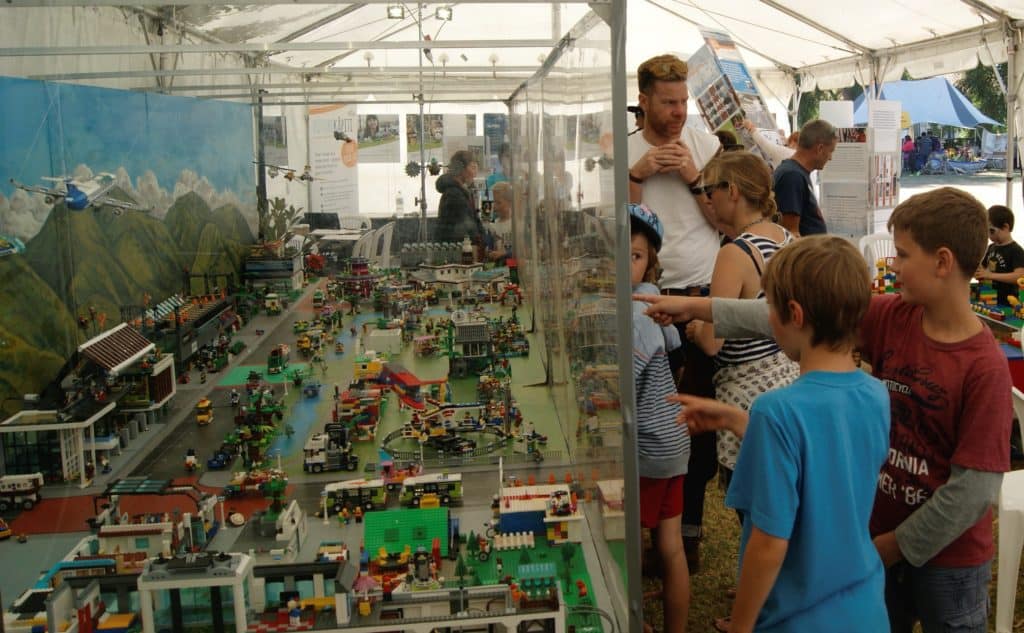Back in 2013, I was sitting at my desk at Kāpiti Coast District Council wrestling with this problem – how do I show the difference between LED streetlights and the old-style orange sodium streetlights in the middle of a sports field on a sunny day? The field and day in question was the upcoming 2014 Sustainable Home and Garden Show. Naturally, I would have to put the lights in a black-out marquee – but then what would entice people come in? And what would the lights be illuminating anyway? As I often did, I turned to my right and discussed this problem with my workmate and friend Ben. A consummate ‘ideas-man’, Ben uttered the fateful words “what about a Lego Town?”
That was the eureka moment and everything flowed from there – working with local Lego fans and other contributors, we created a model sustainable settlement and then the following year we did another, a bigger one modelled directly on plans for the future Paraparaumu town centre. You can read all about the details in a conference paper on the topic here, or in a presentation here. We pioneered an award-winning public engagement method that made potentially dry subject material exciting and interesting to a wide range of people. However, the lack of a focal point at Kāpiti Coast District Council for further projects (the last Sustainable Home and Garden Show was in 2015) meant ‘Lego Town’ didn’t come back in 2016 or 2017.

But this year it is back, and better than ever. As a freelance consultant and as a member of community group Low Carbon Kāpiti, I am in a position to co-ordinate this new project and give it a timely and important purpose – to inspire people to act on climate crisis and help them understand some of the changes we need to secure a sustainable future, and the other benefits we will gain from them. Lego makes this heavy and challenging subject matter safe, fun and easy to explore. Hopefully tens of thousands will see it while it is on show or will hear about it through the internet and media. Through this we are aiming for Low Carbon Kāpiti to gain new members, which will increase our ability to push for our vision of the future, as shown in the display, to become a reality.
Specifically, the display will portray a compressed sample of the Kāpiti Coast, with two distinct settlements (there is no room for more than two regrettably) separated by an open, rural area bounded by the coast at the front and the hills at the back. Major roads and a river will be included too. It will represent the Kāpiti in 2025, just 7 years from now. It is not that far in the future, but this makes the point that the necessary changes are urgent and will have to happen quickly. The world must be net-zero emissions by 2050, so by 2025 aspects of life here in NZ and on the Kāpiti Coast – transportation, housing, business, land use – will already be quite different. So there will be lots of scope for imaginative models!
Here are some ideas we are planning to include – please comment below with your feedback and your own ideas. Who knows, we might take them up and build them, or you could join our effort and build them in yourself! Registration is via the project website here.
Lego Low Carbon Kāpiti 2018 ideas list:
- Solar and wind power
- An organic material recycling and energy plant
- Restored natural habitats and forests
- Medium density housing and mixed-use development
- More recreation and different kinds of shops and business due to automation, e-commerce, 3D printing and lower-consumption lifestyles
- Lots of cyclists, new forms of e-mobility and facilities for them,
- Public transport including a train linking the settlements
- Recreational facilities and other public buildings
- Electric and autonomous vehicles
- Visible influence of Maori culture in the built environment, society and the economy
- Influences of other cultures, especially recent immigrants from countries impacted hardest by climate change
- The effect of a growing and aging population (e.g. apartments and a hospital),
- Different responses to sea level rise and stronger storms
- A sea wall (under repair in one place)
- A house being relocated from the coastal zone
- Floating houses
- Wetlands and canals for floodwater control
One idea that won’t be making the cut is another one of Ben’s. He wanted Kaiju (giant monsters) to be stomping all over the Lego Town. Maybe next year Ben!
P.S. If you’d like to join Low Carbon Kāpiti (instead of or in addition to joining the Lego project) you can do that here. Membership is free.
P.P.S: Yes I know Lego is plastic, and of course plastic presents a major environmental problem too. But we will using nearly all second-hand bricks, and afterwards they will continue to be used over and over again.